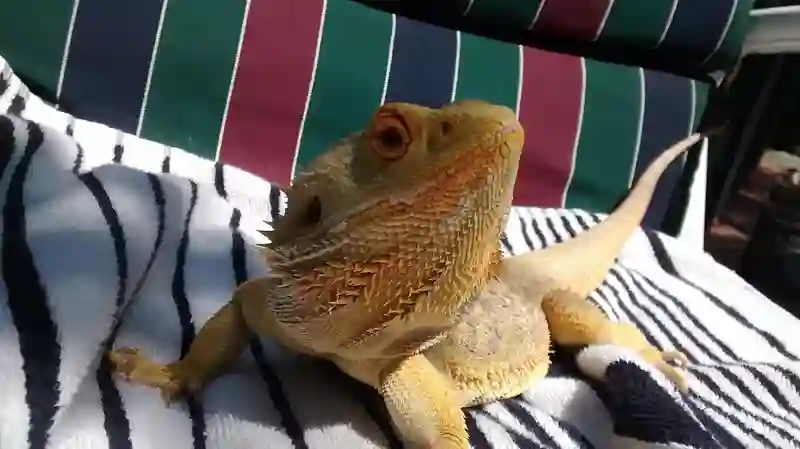No, bearded dragons cannot regrow their tails. Unlike some other species of reptiles, such as leopard geckos, who have the ability to drop their tail as a defense mechanism so they can escape a predator and then regrow their tail, bearded dragons lack the ability to do so and instead have other ways of defending themselves like black bearding, biting, tail whipping, and puffing.
Bearded dragons’ tails are important to them for many reasons, such as balance, communication, and defense. Losing their tail can be a stressful experience for them, and it’s important to make sure they stay both healthy and safe. If a bearded dragon loses its tail due to injury or an accident, it will not grow back
Why Can’t a Bearded Dragon Tails Grow Back?
Autotomy, the ability to drop and regrow a body part, is absent in bearded dragons, resulting in an inability to regrow a lost tail. This is due to the lizard anatomy, which lacks certain tail regeneration mechanisms found in other species.
It is important to prevent tail loss in bearded dragons, as the function of the tail is essential to their behavior and health. Loss of the tail can have an impact on the dragon’s ability to regulate its body temperature and defend itself from predators.
Can Bearded Dragons Drop Their Tails?
No, bearded dragons cannot drop their tails. While some lizards can voluntarily drop their tails as a defense mechanism and then regrow them, bearded dragons lack this ability.
If a bearded dragon loses its tail due to an accident or injury, it will not regrow. However, since all reptiles grow their whole lives, their tail will get slightly longer over the years, but it will never be as long as it used to be
What Can Cause Their Tails To Fall Off?
Tail loss in bearded dragons can be caused by a variety of factors. Bites from other animals, such as other bearded dragons, can lead to the tail dropping off as a defense mechanism.
Tail rot is a bacterial infection that can lead to the tail rotting off. It is caused by an improper environment and/or humidity levels.
Shedding complications may cause the tail to get stuck and eventually fall off.
Finally, in-tank accidents and injuries, such as getting caught on a rock or plant, can cause the tail to break away.
Bites From Other Animals
Predators, such as other lizards, snakes, or birds, may attempt to take bites out of a bearded dragon’s tail, but it cannot be replaced like a lost limb, metaphorically speaking.
Preventing bites is possible through taking some precautions and training the dragon to recognize and avoid predators.
Common predators that may attack a bearded dragon are snakes and birds, so owners should be aware of these risks.
If a bite does occur, it is important to provide first aid and seek veterinary care.
Tail Rot
One condition that can affect a reptile’s tail is tail rot, which is caused by poor husbandry practices and is more likely to occur in wet and humid environments. It is estimated that up to 30% of reptiles in captivity may suffer from this condition.
Tail rot is a progressive condition that can lead to loss of the entire tail if left untreated. The signs and symptoms of tail rot include discoloration, swelling, and foul odor. Treatment for tail rot includes antibiotics, antifungal medications, and regular wound cleaning and dressing.
The best way to prevent tail rot is to practice good husbandry and hygiene, as well as to monitor the environment for signs of dampness and humidity.
Shedding Complications
Shedding complications can arise when a reptile’s tail is not shed properly, leading to difficulty in shedding the tail in its entirety. Improper shedding can occur due to various factors such as low moisture levels, nutrition deficiencies, environmental stressors, and other environmental factors.
In the case of bearded dragons, if the tail is not shed properly and in its entirety, it will not be able to regrow as the autotomy gene is not present. The shedding process should be monitored closely to ensure that it is completed properly and in its entirety.
In-Tank Accidents & Injuries
Injuries and accidents in captivity can occur due to various environmental factors, such as rough surfaces or sharp objects, and can lead to serious injury or death in reptiles.
A recent study found that over 50% of reptiles in captivity suffer from some form of injury or accident, making it important for owners to take proper precautions to ensure the safety of their reptiles.
To reduce the likelihood of an accident or injury, owners should implement prevention measures such as providing a safe enclosure, monitoring their reptiles, and avoiding any objects that could be hazardous.
If an injury does occur, owners should provide first aid and seek out rehabilitation options or even tail prosthetics for their reptiles.
Health Concerns if a Bearded Dragon Loses Its Tail
When autotomy is not present, the loss of a tail can result in serious health complications for the affected animal.
Bearded dragons, for example, are not able to regenerate their tails due to the lack of the autotomy gene. As a result, it is important to take proper care of the tail and take precautions to prevent tail injuries.
This includes providing appropriate basking areas, providing a safe enclosure, and monitoring the dragon’s behavior for any signs of distress. Additionally, tail hygiene is important in order to keep the tail clean and free of parasites.
If a tail injury does occur, it is important to seek veterinary care as soon as possible to ensure the best chance of recovery. There are also alternative methods of tail regrowth that can be explored, such as prosthetics, which can help improve the quality of life for the affected animal.


